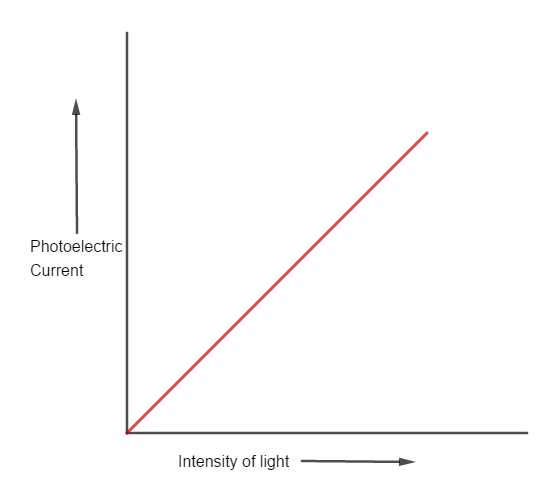
In photoelectric effect, the photo current.
A.Increases with increase of frequency of incident photon
B.Decreases with increase of frequency of incident photon
C.Does not depend on the frequency of the photon but depends only on the intensity of incident light
D.Depends both on intensity and frequency of incident beam
Answer
437.4k+ views
Hint: When monochromatic radiation of suitable frequency falls on a metallic plate, electrons are emitted from it. Thus a current called photoelectric current flows in the circuit setup
Complete answer:
The phenomena of emission of electrons from a metallic surface when it is subjected to electromagnetic radiation of sufficiently high frequency is incident on it, is called the photoelectric effect. The photo (light) generated electrons are called photoelectrons.
This process is known as photoelectric emission and it is an instantaneous process. The time lag between the incidence of light radiation and emission of a photon is very small, even less than${10^{ - 9}}s$.
If we allow radiations of a fixed frequency to fall on any photosensitive material and the accelerating potential between the two electrodes is kept fixed then the photoelectric current is found to be increasing linearly with the intensity of radiation.
Since the photoelectric current is directly proportional to the number of photoelectrons emitted per second, this implies that the number of photoelectrons emitted per second is proportional to the intensity of the incident radiation.
The following graph shows the Photoelectric current vs. intensity of light:

Now, on the other hand, the maximum kinetic energy of the photoelectrons increases linearly with the frequency of the incident radiation. Thus frequency only limits the kinetic energy of the emitted photons. But still, a suitable frequency of radiation is required to initiate the process of photon emission, known as the threshold frequency.
Therefore, the correct option is D. i.e., photocurrent depends on both the intensity and frequency of the incident beam.
Note:
Above the threshold frequency of a photosensitive material, the stopping potential or equivalently the maximum kinetic energy of the photoelectrons is directly proportional to the frequency of the incident radiation, but is independent of its intensity.
Complete answer:
The phenomena of emission of electrons from a metallic surface when it is subjected to electromagnetic radiation of sufficiently high frequency is incident on it, is called the photoelectric effect. The photo (light) generated electrons are called photoelectrons.
This process is known as photoelectric emission and it is an instantaneous process. The time lag between the incidence of light radiation and emission of a photon is very small, even less than${10^{ - 9}}s$.
If we allow radiations of a fixed frequency to fall on any photosensitive material and the accelerating potential between the two electrodes is kept fixed then the photoelectric current is found to be increasing linearly with the intensity of radiation.
Since the photoelectric current is directly proportional to the number of photoelectrons emitted per second, this implies that the number of photoelectrons emitted per second is proportional to the intensity of the incident radiation.
The following graph shows the Photoelectric current vs. intensity of light:

Now, on the other hand, the maximum kinetic energy of the photoelectrons increases linearly with the frequency of the incident radiation. Thus frequency only limits the kinetic energy of the emitted photons. But still, a suitable frequency of radiation is required to initiate the process of photon emission, known as the threshold frequency.
Therefore, the correct option is D. i.e., photocurrent depends on both the intensity and frequency of the incident beam.
Note:
Above the threshold frequency of a photosensitive material, the stopping potential or equivalently the maximum kinetic energy of the photoelectrons is directly proportional to the frequency of the incident radiation, but is independent of its intensity.
Recently Updated Pages
Class 12 Question and Answer - Your Ultimate Solutions Guide

Master Class 12 Social Science: Engaging Questions & Answers for Success

Master Class 12 Physics: Engaging Questions & Answers for Success

Master Class 12 Maths: Engaging Questions & Answers for Success

Master Class 12 English: Engaging Questions & Answers for Success

Master Class 12 Chemistry: Engaging Questions & Answers for Success

Trending doubts
Explain sex determination in humans with the help of class 12 biology CBSE

Give 10 examples of unisexual and bisexual flowers

Distinguish between asexual and sexual reproduction class 12 biology CBSE

How do you convert from joules to electron volts class 12 physics CBSE

Derive mirror equation State any three experimental class 12 physics CBSE

Differentiate between internal fertilization and external class 12 biology CBSE




